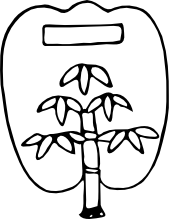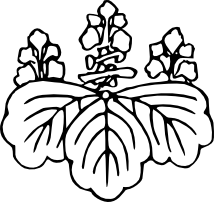Recreational research into Feudal Japan
Archive for May, 2010
Mon of the Week: Hollyhock
May 31st (a Sembu (先負))
Continuing our pass through 15th century rural samurai mon,(KJ:7) this week we have a straightforward one. It shows two hollyhock leaves with a bud, arranged representationally.
Unlike the previous few weeks’ mon, this design has been preserved almost unmodified through the centuries; compare this similar modern mon.(IEJFC:8)
One interesting thing about the Japanese used to describe mon is that, while mon descriptions are basically standard Japanese, small changes in the description can be significant. Here, the two leaves are counted as 二葉/futaba, or “two leaves”. Mon counted in this way use representational designs. In later times, geometric designs became more popular; these might be described similarly, but counted with 二つ/futatsu, or “two things”. In essence, the difference is between a “two-leaved hollyhock” and “two hollyhock leaves”. You can see the difference in the Tokugawa mon, which uses the つ/tsu counter.
Mon of the Week: Fan with Bamboo
May 23rd (a Senshō (先勝))
This week we look at another 15th-century rural samurai mon.(KJ:7) It shows what appears to be a nonfolding paper fan decorated with a bar, possibly the character for “one”, with a bamboo stem with leaves serving as the handle.
This is similar to a mon in use today, depicting a T’ang dynasty fan (唐団扇/tō uchiwa) with bamboo grass (笹/sasa).(IEJFC:39)
The shape of the fan is somewhat different in the more recent mon; my interpretation is that the design became more stylized as mon became standardized in the Edo period. This also shows how earlier mon had more flexibility in combining multiple unrelated elements in ways later mon would not. In addition, the bamboo stem in the modern one has become more stylized, somewhere between an actual bamboo stem and a fan rod. However, these two mon also show the consistency of mon in different eras, even as the ways mon were created, assigned, and used changed.
ADDED INFO:
A similar fan mon with a simplified, filled design and a simple post instead of the bamboo detail was used by Okudaira Nobumasa in the siege of Nagashino Castle in 1575.(SH:D5,59)
Mon of the Samurai
May 3rd (a Butsumetsu (仏滅))
Widespread battlefield use of mon seems to date to the Gempei War (1180-1185), where they were used on banners alongside Buddhist prayers, Shintō invocations, and heroic poetry. While it’s unclear if the two warring clans actually used the mon they were later associated with (butterfly for the Taira, gentian for the Minamoto), Heike Monogatari does contain clear references to mon on banners.(SH:10)
By the Muromachi period (1336–1573), samurai commonly adopted mon to identify themselves. A compilation of mon used by provincial samurai from around 1460–1470 shows some interesting things. While most of the elements are recognizable from modern mon, there are some elements and variation that did not persist. Without a central authority, samurai were less constrained in terms of shape, arrangement, and combination of elements than post-standardization mon from the Edo period.(KJ:7)
Here is a sample from this compilation: a classic paulownia mon with the insertion of the character 安 or ‘peace’. These are both common elements, though the location of a character in the middle of the flower is an unusual arrangement that did not end up becoming standard.(KJ:7)








